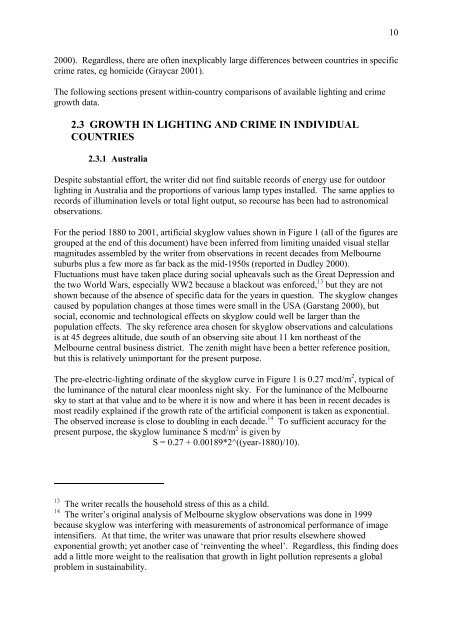Outdoor Lighting and Crime - Amper
Outdoor Lighting and Crime - Amper
Outdoor Lighting and Crime - Amper
Create successful ePaper yourself
Turn your PDF publications into a flip-book with our unique Google optimized e-Paper software.
2000). Regardless, there are often inexplicably large differences between countries in specific<br />
crime rates, eg homicide (Graycar 2001).<br />
The following sections present within-country comparisons of available lighting <strong>and</strong> crime<br />
growth data.<br />
2.3 GROWTH IN LIGHTING AND CRIME IN INDIVIDUAL<br />
COUNTRIES<br />
2.3.1 Australia<br />
Despite substantial effort, the writer did not find suitable records of energy use for outdoor<br />
lighting in Australia <strong>and</strong> the proportions of various lamp types installed. The same applies to<br />
records of illumination levels or total light output, so recourse has been had to astronomical<br />
observations.<br />
For the period 1880 to 2001, artificial skyglow values shown in Figure 1 (all of the figures are<br />
grouped at the end of this document) have been inferred from limiting unaided visual stellar<br />
magnitudes assembled by the writer from observations in recent decades from Melbourne<br />
suburbs plus a few more as far back as the mid-1950s (reported in Dudley 2000).<br />
Fluctuations must have taken place during social upheavals such as the Great Depression <strong>and</strong><br />
the two World Wars, especially WW2 because a blackout was enforced, 13 but they are not<br />
shown because of the absence of specific data for the years in question. The skyglow changes<br />
caused by population changes at those times were small in the USA (Garstang 2000), but<br />
social, economic <strong>and</strong> technological effects on skyglow could well be larger than the<br />
population effects. The sky reference area chosen for skyglow observations <strong>and</strong> calculations<br />
is at 45 degrees altitude, due south of an observing site about 11 km northeast of the<br />
Melbourne central business district. The zenith might have been a better reference position,<br />
but this is relatively unimportant for the present purpose.<br />
The pre-electric-lighting ordinate of the skyglow curve in Figure 1 is 0.27 mcd/m 2 , typical of<br />
the luminance of the natural clear moonless night sky. For the luminance of the Melbourne<br />
sky to start at that value <strong>and</strong> to be where it is now <strong>and</strong> where it has been in recent decades is<br />
most readily explained if the growth rate of the artificial component is taken as exponential.<br />
The observed increase is close to doubling in each decade. 14 To sufficient accuracy for the<br />
present purpose, the skyglow luminance S mcd/m 2 is given by<br />
S = 0.27 + 0.00189*2^((year-1880)/10).<br />
13 The writer recalls the household stress of this as a child.<br />
14 The writer’s original analysis of Melbourne skyglow observations was done in 1999<br />
because skyglow was interfering with measurements of astronomical performance of image<br />
intensifiers. At that time, the writer was unaware that prior results elsewhere showed<br />
exponential growth; yet another case of ‘reinventing the wheel’. Regardless, this finding does<br />
add a little more weight to the realisation that growth in light pollution represents a global<br />
problem in sustainability.<br />
10
















